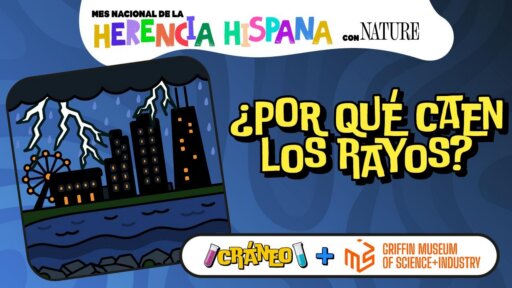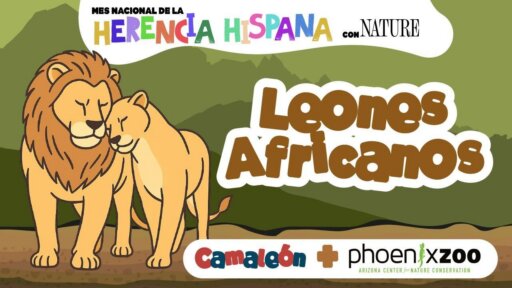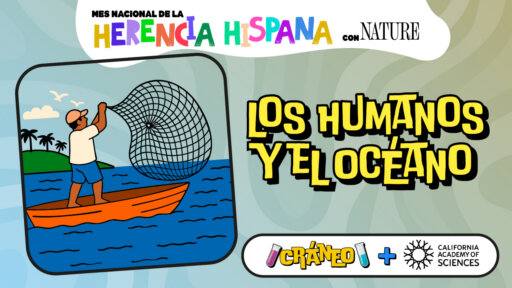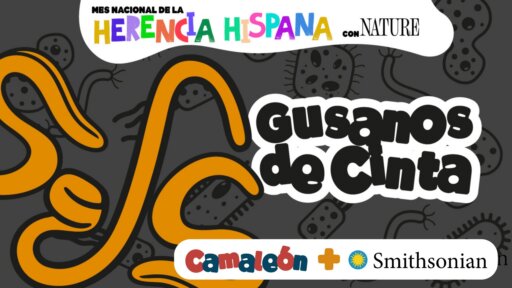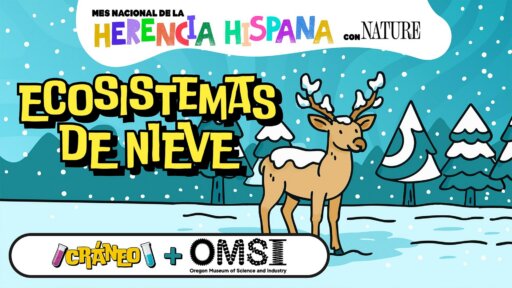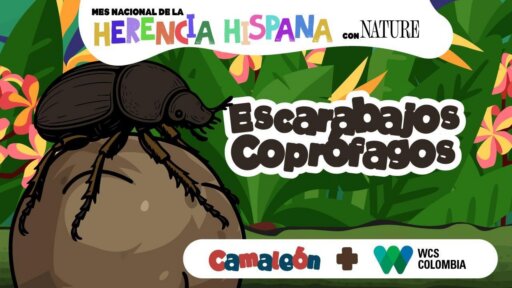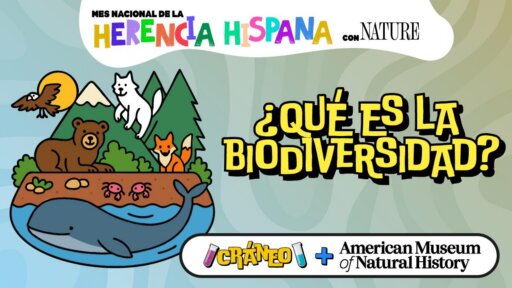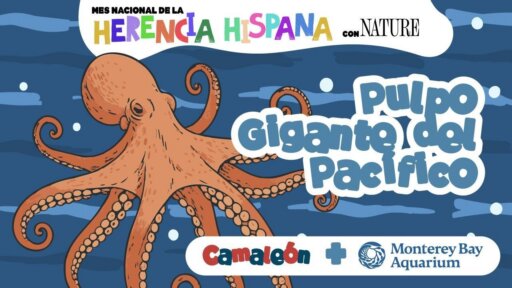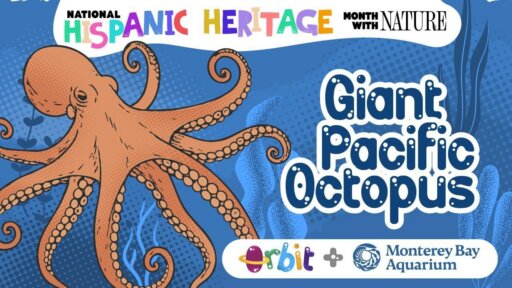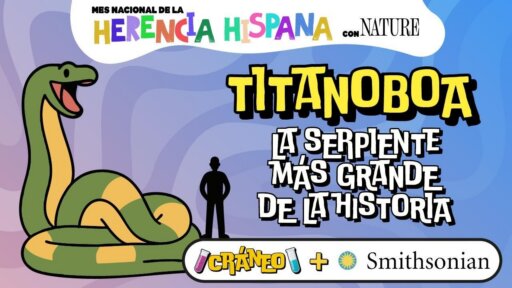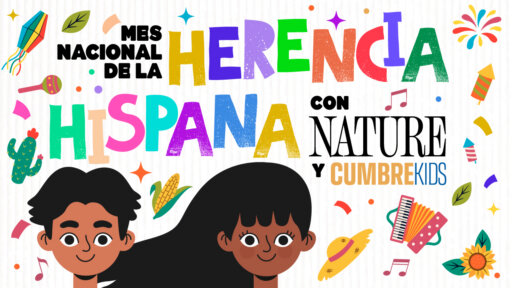TRANSCRIPT (EN)
Gerwuin 00:00
Hello, parents. This episode is part of a special celebration for Hispanic Heritage Month. We want to give a special thank-you this month to the PBS Nature team, who have been collaborators in making this content possible. If your little ones want to send questions, they can go directly to [www.cumbrekids.org/preguntas](http://www.cumbrekids.org/preguntas) or to the link we’re leaving in the episode description. Now let’s start the episode.
Gerwuin 00:30
OK, chameleons. Kids, close your eyes, imagine you’re on the beach at night. Everything is dark until you move your hands in the water and suddenly the sea starts to glow as if thousands of fireflies were swimming around you. Today we’re going to discover what causes that natural light show: the bioluminescent phytoplankton of Puerto Rico.
Kids 01:01
Which types of phytoplankton glow and which don’t? How has phytoplankton evolved over the years to become bioluminescent? And what would happen if phytoplankton went extinct?
Gerwuin 01:15
And to learn it we’ll have a very special guest, Brenda María Soler Figueroa, a researcher at the Smithsonian Environmental Research Center, who will tell us all about these tiny creatures that light up the ocean.
Brenda 01:30
Hello everyone, I hope you’re doing very well. I’m Brenda María Soler Figueroa and I’m super happy to be here today with you.
Gerwuin 01:38
Are you ready to join me on this adventure? Well then, let’s go.
Gerwuin 01:46
Hello, chameleons,
Gerwuin 01:50
So good to greet you. I’m Gerwin Riera and today we have an amazing episode. Today Josué is joining us from Costa Rica. We’ve had him on other occasions and we’re happy you’re here. Josué, say hi to all the kids. How are you?
Josue 02:04
Very well, Gerwin, and you? And greetings to all the chameleons who listen to our podcast.
Gerwuin 02:10
Good, Josué, tell me about you. What has happened in your life since the last time we talked on this podcast? Tell me a bit about you. What do you have to tell me?
Josue 02:20
I’m going to soccer classes, and yesterday was my first match.
Gerwuin 02:24
Wow, what was it like to have your first match? How was that?
Josue 02:29
Nice, but we ended up losing like five to one.
Gerwuin 02:38
Five to one, but it doesn’t matter because it’s your first match, right? Of course. And what’s your favorite soccer team, Josué?
Josue 02:47
In Costa Rica, Liga Deportiva Alajuelense, and outside this country, Barcelona.
Gerwuin 02:57
Ah, how cool! Hey, Josué, and I remember that last time we talked about your little animals, the turkeys, the hens, everything you had there at home. Tell me about that. How’s it going?
Josue 03:09
I have a new animal.
Gerwuin 03:12
Oh, yeah? What animal is it?
Josue 03:14
A bunny.
Gerwuin 03:15
A bunny that’s named…?
Josue 03:17
Coneji.
Gerwuin 03:18
Coneji, perfect. And what can you tell me about what’s happening right now over there with all your animals?
Josue 03:24
Some predators got into the chicken coop to eat the hens and the turkeys.
Gerwuin 03:32
Oh, it can’t be. How did you know those were the predators? Or which predators were they?
Josue 03:39
We’re considering either raccoon or coati or weasel—well, we think it’s more likely the raccoon.
Gerwuin 03:48
OK, you’re leaning more toward a raccoon getting in and…
Josue 03:52
We saw some tracks that looked like raccoon tracks.
Gerwuin 03:55
Right, so you’re doing everything necessary to control the place, right, and so the animals can feel more protected, right?
Josue 04:04
Grandpa and I are making spaces to keep them safer.
Gerwuin 04:10
That’s great. You’ve then had the opportunity to have lots of animals nearby, which is already something cool for the podcast because you have the experience of having many little animals close by, and you’re almost a scientist, Josué, and I congratulate you for that, so thanks for sharing all that about your home.
Gerwuin 04:35
Very well, Josué, so today we’re going to move on to a little game. I have a riddle here. Do you also have a riddle prepared for me?
Josue 04:43
Yes.
Gerwuin 04:44
OK, let’s start. I have hands (needles), but I don’t poke. I mark time without stopping. And even though I never walk, you’ll always see me moving. What am I?
Josue 04:57
Could it be the clock?
Gerwuin 04:59
It’s the clock. Very good, that’s right. Josué, the clock. Perfect, perfect, perfect, perfect. Hey, and do you also have some for me?
Josue 05:10
Which animal takes the longest to put on shoes?
Gerwuin 05:16
Which animal takes the longest to put on shoes? What do you think, chameleons? I think the centipede.
Robert 05:27
Yes, correct. Yes, very good,
Gerwuin 05:32
very good, very good, very good, very good. Do you have another?
Josue 05:37
Yes: Loaded they go, loaded they come, and they never stop.
Gerwuin 05:42
Loaded they go, loaded they come, and they never stop. Loaded they go, loaded they come, and they never stop. What do the chameleons think? I think it’s the ant.
Josue 05:55
Yes, correct. Correct.
Gerwuin 06:01
Very good, Josué, we did it.
Gerwuin 06:03
I have another one for you. I fly without wings, I sing without a voice. And if you catch me, I escape quickly. Who am I?
Josue 06:13
Could it be the wind?
Gerwuin 06:15
Yes, it’s the wind. Perfect. Very good, very good, very good, very good, we did it. Josué, today we’re going to talk about the bioluminescent phytoplankton of Puerto Rico. Had you heard of that species?
Josue 06:31
Plankton yes, and “phyto” no.
Gerwuin 06:34
Plankton yes, and “phyto” no, of course. So I’ll explain a little. “Phyto” means plant and “plankton” means that it floats. They are tiny organisms that live in water and float in the sea.
Josue 06:46
That sounds like a plastic plant,
Gerwuin 06:51
It sounds like a plastic plant, but it’s not plastic. So, since it’s not plastic, we understand that these are organisms that are there in the sea. Now, they don’t swim. They let themselves be carried by the current, and even though they’re very tiny, together they form huge groups in the ocean. You can see them with the naked eye. They seem like just water, but sometimes they tint the sea green or blue.
Josue 07:17
How strange. So they’re small, but they do big things.
Gerwuin 07:21
Exactly. We’re not going to tell everything yet because our guest will help us discover more, but we already know that phytoplankton are tiny, float, and are very important for life in the sea. Now let’s look closely at what we have here in the images. What do you see on the screen, Josué?
Josue 07:40
Like some water. The water looks kind of clear.
Gerwuin 07:46
Yes, it has like a light.
Josue 07:48
Because you can see like little points of light like stars, a bright blue, that are in the sea.
Gerwuin 07:57
Exactly, as if the sky were in the sea practically, right? Yes. And what do you like most about seeing that image? What most catches your attention?
Josue 08:06
The bright colors that are moving.
Gerwuin 08:09
They’re moving. Perfect. So the images we see are of a sea, and everyone—the chameleons—can also see them there on Spotify with our friend Jorge Wake, who is drawing the open sea with different colors in the same sea while the water is moving. That—that is the phytoplankton. So, well, that’s what we’re going to talk about today. But before moving on to the conversation with our guest, we have a song prepared with Josué. What do you think, Josué? Shall we start singing?
Josue 08:42
Yes
Gerwuin 08:42
OK, then I ask all the chameleons to stand up right now and we’re going to start singing and also dancing and moving a little. Sound good?
Gerwuin and Josué 08:54
Let’s go, Josué
Josue 08:56
In the water of the sea, something shines nonstop.
Gerwuin 09:00
They are tiny friends who come to
Josue 09:03
help us. When the water moves, little lights appear— that magical phytoplankton that wants to say hello.
Gerwuin and Josué 09:14
It shines, shines in the sea like stars that want to play. Phytoplankton gives us its magical blue treasure
Gerwuin and Josué 09:26
it shines, shines in the sea like stars that want to play, magical phytoplankton, blue treasure
Gerwuin 09:34
At night they light up,
Josue 09:38
They seem to dream. With their light, they protect life in the sea,
Gerwuin 09:44
They give air to the earth,
Josue 09:47
They make us sing.
Gerwuin 09:49
The phytoplankton always
Josue 09:52
wants to take care of us.
Gerwuin and Josué 09:55
It shines, shines in the sea like stars that want to play. Phytoplankton gives us its light, magical blue treasure.
Gerwuin 10:15
Very good, Josué—perfect, perfect, perfect, perfect, perfect. And to discover more about this microscopic world, today we have a very special guest. Do you want to introduce her?
Josue 10:27
Yes, today Brenda joins us, who is a researcher who studies these tiny organisms of the sea. Hi, Brenda, do you have a favorite animal?
Brenda 10:40
My favorite animal is the iguana because I find them super beautiful, but today I actually want to tell you about some very tiny microorganisms that we can’t see with the naked eye and are called dinoflagellates.
Josue 10:56
Great, Brenda. I love iguanas too. And what inspired you to study the sea?
Brenda 11:03
Oh yes, what a nice question. Well, I’ll tell you that I was born, grew up, and was raised in Puerto Rico, which is a place with a very beautiful and diverse environment. There are beaches with crystal-clear waters and white sands, a tropical rainforest, and also a dry forest. I liked seeing what was under the water so much that I decided to study marine sciences.
Gerwuin 11:28
Super! And what do you do in your job, Brenda?
Brenda 11:30
Yes, well, I’m a researcher in the invasive marine species laboratory at the Smithsonian Environmental Research Center, and I study the phytoplankton that travel in the water carried by commercial ships. This water can transport these microorganisms to very distant places, and that can be a problem because some of these microorganisms can affect the animals and plants that live there.
Gerwuin 12:01
Good, Josué, what do you think if we go discover the secrets of phytoplankton together?
Josue 12:07
Yes, let’s begin
Gerwuin 12:09
Chameleons, now let’s enter the world of the bioluminescent phytoplankton of Puerto Rico. Well, I’ll tell you that I had the opportunity to be at the sea and see it with my own eyes, and it’s truly incredible. Well, these flashes of light are produced by some tiny organisms called dinoflagellates. And you might say, dinosaurs of what? Right. To understand better, let’s see what our guest Brenda tells us, who, as you already know, is visiting us from the Smithsonian.
Brenda 12:36
Well, these dinoflagellates are kind of round, as if they were little balls or very tiny spheres with two tails that we call flagella. One of the flagella goes around the organism’s body like a belt and helps them spin in the water, and the other comes out of the back and helps them move forward.
Gerwuin 13:04
What a good strategy for moving in the water.
Brenda 13:09
This dinoflagellate also has a structure on the top that looks like a horn and another on the bottom that looks like a spine. And it’s believed these structures help it float and stay in the water.
Gerwuin 13:26
Incredible. They even seem designed to survive in any corner of the ocean.
Brenda 13:30
Many dinoflagellates, including the bioluminescent ones in Puerto Rico, are covered by plates of cellulose, which is the same material that leaves of trees and the paper we write on have. These plates are called thecae and they work like a shell, giving them protection.
Gerwuin 13:50
Wow, so many things one can’t see unless it’s with microscopes.
Brenda 13:55
The thecae also have small holes called pores, which allow them to sense what’s happening around them and let things like water and gases pass through. And what makes them so special is that they can glow in the dark, a phenomenon called bioluminescence, which happens when living organisms produce light by themselves, just like fireflies do, which perhaps many of the kids have seen.
Gerwuin 14:26
Of course, fireflies are beautiful. I’m a big fan. Well, and speaking of kids, let’s see what questions our chameleons have.
Brenda 14:34
Of course.
Boy: Gael Antonio 14:35
Hello, chameleon, my name is Gael Antonio, I live in Heredia, Costa Rica, and my question is: What does phytoplankton mean and what is the scientific name?
Brenda 14:57
Hello Gael and thank you for your question. Phytoplankton is made up of very small organisms that live on the surface of the water in oceans, rivers, and lakes. They are so, so, so small that they have just a single cell. Unlike us humans who have many cells, they can’t swim much, so they move with the water currents. And there are many different species of phytoplankton, and each one has its own scientific name. The scientific name of the bioluminescent dinoflagellate we find in Puerto Rico is Pyrodinium bahamense. The word “Pyro” comes from Greek and means fire, because this organism can produce light. “Dinium,” which is a scientific word that comes from the Greek word “dinos,” means to spin, because these organisms move by spinning their two flagella or tails, and “bahamense” is like the surname because it indicates that it was identified or first observed in the Bahamas, and in fact it’s a species that is very common in the Caribbean, including Puerto Rico.
Gerwuin 16:10
What a spectacular name—if we put it all together it would be Pyrodinium bahamense, which means spinning fire organism from the Bahamas. Sounds powerful, doesn’t it, chameleons?
Boy: Hector Emilio 16:22
Hello, my name is Héctor Emilio, I’m 5 years old, I live in Michigan, and my question is: what kind of phytoplankton has light and which doesn’t?
Brenda 16:34
Excellent question, Héctor Emilio. There are several groups of phytoplankton, like diatoms, coccolithophores, cyanobacteria, dinoflagellates, and silicoflagellates. But of these, only dinoflagellates can produce light because they have special substances inside their bodies that allow them to glow in the dark. It’s as if they had their own internal flashlight. The other types of phytoplankton do not have these—sorry—these special substances and therefore do not produce light.
Girl: Alisa 17:15
Hello, my name is Alisa, I’m five years old, in Saltillo, Mexico, and my question is: Why do phytoplankton glow?
Brenda 17:26
Oh, thanks for that very important question, Alisa. Dinoflagellates glow to defend themselves from predators. That special light you mention, called bioluminescence, is caused by a chemical reaction inside the dinoflagellate. This reaction needs two special substances called luciferin and luciferase. When these substances come together, they produce a blue-green flash of light that we can see in the water. It’s something similar to glow sticks, those colored sticks you may have seen. Inside those sticks there are two separate liquids that, when you bend them, the liquids mix and make the stick glow.
Girl: Samantha 18:13
Hello, chameleons. My name is Samantha and I live in Mexico. Why does the water light up when you move your arms in it?
Brenda 18:27
Very good question, Samantha. Dinoflagellates do not glow all the time. They only do so when something moves the water. For example, if you put your hand in and stir the water. Or if you’re swimming. Or when there are waves, winds. Or even when fish swim. That movement sends a signal to the dinoflagellate’s cell and activates a series of internal reactions—which means they happen inside the cell. At the end of these reactions, the special substances that let them glow—luciferin and luciferase—come together and produce the flash of light that we can see. Now then, this flash in dinoflagellates lasts only a few seconds, unlike glow sticks that glow for much longer.
Gerwuin 19:24
Chameleons, I want us to think about something different. We already talked about how they look, why they glow, and how they react to movement. But did you know that phytoplankton also helps scientists learn about the ocean’s health? Researchers observe the amount and type of phytoplankton to know if a marine ecosystem is healthy or in danger. For example, when there are too many nutrients in the water, phytoplankton can grow out of control and form what we call a bloom. Some of these blooms change the color of the water and can even be toxic to fish and other animals. Also, studying phytoplankton gives scientists clues about how the climate is changing. By seeing where more or less phytoplankton appears, they can better understand how ocean currents move and how heat is distributed on the planet. So besides glowing and feeding other living beings, they also work like a natural thermometer that tells us what’s happening in the sea. That’s really surprising.
Gerwuin 20:30
OK, but it’s time for our Chameleon Moment. Our podcast takes on a mysterious tone to figure out the sound of an animal you’ll soon hear. What animal will it be? Got it? Tell me at the end.
Boy: Jeudiel 20:52
Hello, chameleons. My name is Javier, I live in Querétaro, Mexico, I’m five and a half years old, and my question is: how do the animals that glow underwater in that place manage to survive without being gulped down in one bite?
Brenda 21:12
Hello, Jeudiel. Thanks for your question. The light of the dinoflagellates works like a car alarm—imagine, or maybe you’ve heard, right? When you touch a car without permission, a loud alarm goes off to scare the thief or alert others—even the police—that something is happening. In a similar way, dinoflagellates use bioluminescence as an alarm to defend themselves from predators.
Gerwuin 21:43
Wow, that’s really interesting. And how do they do it?
Brenda 21:47
For example, when a very small fish is feeding on them, the movement of the water makes the dinoflagellates glow. That light then attracts the predator of the smaller fish. It’s as if the dinoflagellates were shouting with light, “Help, they want to eat me!” and that way they manage to avoid being eaten. Incredible.
Gerwuin 22:15
That really is a brilliant strategy.
Boy: Bruno 22:19
Hello, Chameleon, my name is Bruno León. I’m nine years old, I live in Monterrey, Mexico, and my question is: How has phytoplankton evolved over the years to become bioluminescent?
Brenda 22:32
That’s a very interesting question, Bruno. The dinoflagellates that glow weren’t always like that. Millions of years ago, some species began to produce the two special substances we mentioned earlier, luciferin and luciferase, which, when combined, produce the flash of light. Over time, this ability to glow helped them defend themselves from predators.
Gerwuin 22:58
Wow, it’s impressive to think that evolution turned light into a shield for these tiny beings.
Boy: Job 23:05
Hello, I’m Job, I’m six years old, I live in Chiapas, Mexico, and my question is: How deep do they live and why don’t we see them so often?
Brenda 23:20
Excellent question, Job. Many species of phytoplankton live in the upper layers of the ocean, rivers, and lakes, in a zone that we scientists know as the photic zone, which is how far sunlight reaches in the ocean. For example, this zone can reach up to 200 meters deep. And this happens because many species of phytoplankton, including some dinoflagellates, are photosynthetic. That means they need sunlight, carbon dioxide, and nutrients in the water to produce their own food, just like land plants do.
Gerwuin 24:05
Right, that’s why without light they can’t do photosynthesis and prefer to stay where there’s more brightness. Chameleons, and there are other species that can live in deeper parts because they don’t need to do photosynthesis. And if you’re wondering, photosynthesis is a biochemical process exclusive to plants and to these species, which captures and transforms solar energy into chemical energy, which means that with their leaves they trap the sunlight, mix it with water and air, and turn it into energy to grow and live.
Brenda 24:36
And why don’t we see them? Well, because most phytoplankton—this means they are so, so, so, so small that we can’t see them with the naked eye. To observe them we need a microscope, which is an instrument with special lenses that make images look much larger so we can see details that are invisible to our eyes.
Gerwuin 25:08
And now, chameleons, I want us to go into ocean-detective mode. We already know how they glow and where they live, but did you know that phytoplankton also influences the colors of the sea that we see from the beach or even from space? When there’s a lot of phytoplankton in an area, the water can look greener because these tiny cells have chlorophyll just like plants. In other places, the concentration is so low that the sea looks deep blue. Satellites orbiting the Earth use that difference in colors to take photos and maps that help scientists know how much microscopic life there is in every corner of the planet, so they can better understand where there’s more food for fish and whales and how the oceans change with the seasons. I start to think that the next time I approach the sea, I won’t just be seeing water—I’ll be seeing millions of tiny species that color the ocean every day. OK, but let’s keep listening to the mysterious animal. What animal could it be? Could it be a crocodile? Could it be a turtle? Or could it be a snake? You got it? Tell me at the end.
Girl: Antonia 26:36
Hello, chameleon, my name is Antonia, I live in Canada, and my question is: What happens if phytoplankton go extinct?
Brenda 26:48
What a great question, Antonia. All aquatic animals depend on phytoplankton in order to live, since they form the base of the food web. Even we humans need phytoplankton, since they produce around 50% of the oxygen we breathe. If phytoplankton disappeared or went extinct, life would be very difficult or even impossible on planet Earth, because there wouldn’t be enough food for aquatic animals nor oxygen for us and the rest of living beings.
Gerwuin 27:30
Hey, Brenda, and what role does phytoplankton play in the ocean’s food web? Who eats it and whom does it help?
Brenda 27:36
Phytoplankton is super important in the ocean and in other bodies of water because it’s the beginning of the entire food web—or as we also say, the food network in the water. These organisms produce their own food using sunlight, as we mentioned earlier, and they are the main food of zooplankton, which are also aquatic animals, also very, very tiny.
Gerwuin 28:04
Right, then small fish eat the zooplankton, bigger fish eat those smaller fish, and that’s how energy passes from one animal to another until it reaches the largest, like whales and sharks. Wow.
Brenda 28:18
That’s why phytoplankton is essential, because it helps all aquatic life to have energy to live, grow, reproduce, and survive.
Gerwuin 28:29
Impressive. Well, we’re reaching the end of this episode, Brenda, but before that let’s review everything we’ve learned. We discovered that phytoplankton is made up of tiny organisms like dinoflagellates, which can glow in the dark thanks to bioluminescence. We also heard that not all glow—only some—and that they do it as a defense strategy against predators. We also learned that phytoplankton lives mainly in the zone where sunlight reaches because many do photosynthesis, and most importantly, we understood that they are the base of life in the sea, because they sustain the entire food web and without them there would be no fish, whales, nor balance in our oceans. Brenda, it has been a true honor to have you with us. Thank you for teaching us so much, for inspiring the chameleons to care for and value marine life. What would you say to children who want to be scientists like you?
Brenda 29:22
Oh, what a lovely question. Well, to study the sea and the creatures that live there, a person needs to learn many things that I think are super interesting. Some important subjects are biology, chemistry, mathematics, and many other sciences because they help us understand how animals and plants live and how the oceans and seawater work. But more than having special skills, I think the most important thing for girls and boys who want to be marine scientists is to have enthusiasm and motivation to learn new things. You also have to be persistent and feel a lot of passion for what you do.
Gerwuin 30:09
Very good. Bye, Brenda. Thank you very much.
Brenda 30:12
Oh, goodbye. I loved being here today with you. Thank you very much for the invitation and until next time.
Gerwuin 30:18
And before we finish, let’s greet some chameleons. Greetings to Salvador from Chile, the city of Castro on the island of Chiloé. We also greet Amaru from Bogotá, Colombia; Luis Mario from Floridablanca in Colombia. We also greet León Novoa from Montevideo, Uruguay; Lucía from Escazú, San José; and also Victoria from Bogotá. Thank you so much for being part of this Chameleon family. I hope you enjoyed it a lot.
Gerwuin 30:54
OK, we heard Brenda talk about the phytoplankton. Josué, what did you think about everything we talked about with Brenda—amazing. Did you like it a lot? Did you learn a lot?
Josue 31:04
Yes
Gerwuin 31:04
So good to know, because today we have a question challenge for you. And of course, you’ve also taken notes to ask me some questions, right?
Josue 31:11
Yes
Gerwuin 31:12
We’re going to give you the time to start.
Josue 31:14
Okay. Are phytoplankton plants, animals? Or what are they?
Gerwuin 31:20
Let’s see, what do the chameleons who are listening think? Is it an animal? Is it a plant? Or what is it? I’m going to prepare my ukulele for the answer. Phytoplankton, I think, is neither an animal nor a plant like the ones we see in the garden. They are microscopic organisms that do photosynthesis like plants but that live floating in the water. Is that correct or not?
Josue 31:45
Josué—correct. Hey, correct, correct, correct, correct.
Gerwuin 31:52
Now it’s my turn, Josué. Let’s see—what does phytoplankton do that is super important for all living beings on Earth?
Josue 32:02
It produces oxygen?
Gerwuin 32:04
Yes, it produces oxygen. Very good, very good, very good, very good, very good.
Gerwuin 32:10
Now you—
Josue 32:11
Does every type of phytoplankton glow in the dark?
Gerwuin 32:16
Let’s see what the chameleons think. Do they all glow in the dark? I think not—only some. The ones that glow are the dinoflagellates thanks to their special substances that they have in their bodies. Is that correct? Josué—correct, very good, correct, correct, correct, correct, correct. We both win, but the real winners are the chameleons who play and learn with us. Sound good? Yes. Guess what’s coming, Josué? What’s coming up?
Josue 32:48
The mysterious sound.
Josue 32:57
Is it a crocodile? Is it a crocodile? Is it a turtle? Or is it a snake?
Gerwuin 33:04
Is it a crocodile? Is it a turtle? Or is it a snake? What do the chameleons say? Could it be that I’m going to lose today to Josué? A turtle?
Josue 33:18
No, no. It was a crocodile.
Gerwuin 33:26
A crocodile. Of course, it was a crocodile. Congratulations to all the kids who guessed it was a crocodile, but I lost. Hey, Josué, do you know the credits? Because we’re reaching the end of this episode—In executive production…
Josue 33:41
Robert Carpenter
Gerwuin 33:43
In graphic design…
Josue 33:45
Moisés Monsalve
Gerwuin 33:46
And the drawings…
Josue 33:48
Jorge Wake.
Gerwuin 33:49
We’ve reached the end, chameleons, of this episode, and we learned a lot. I’m grateful to share with Josué and with all of you. I’ll say goodbye. Josué, say goodbye to all the kids.
Josue 34:01
Bye, chameleons.

